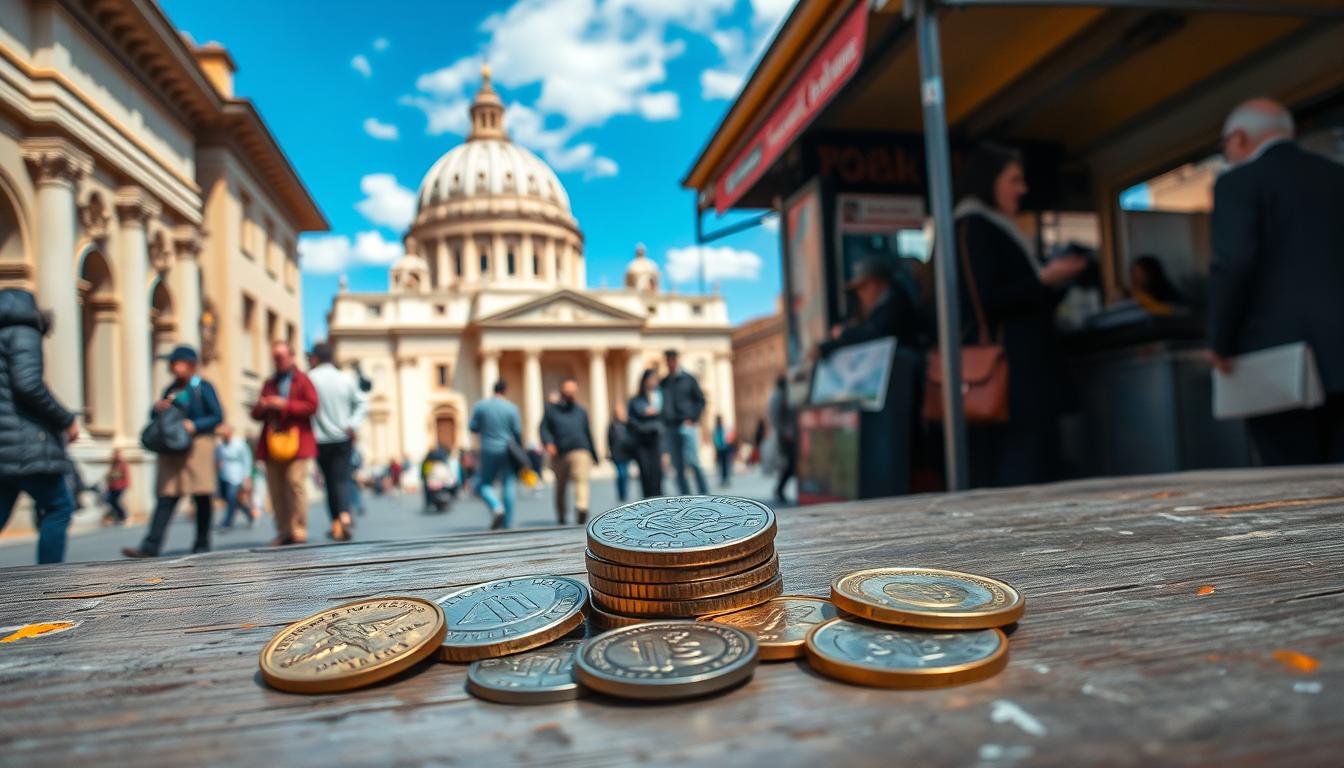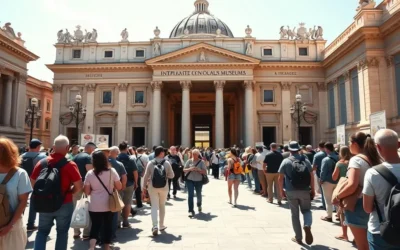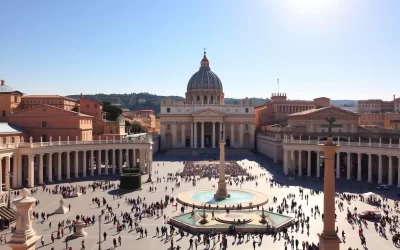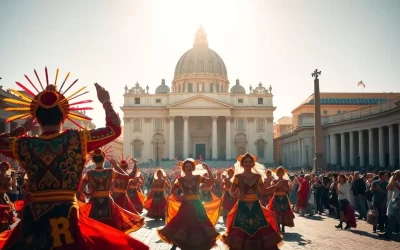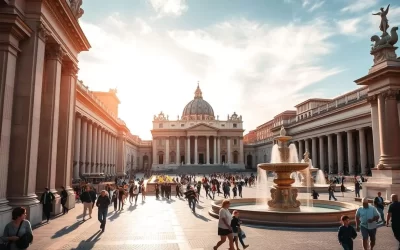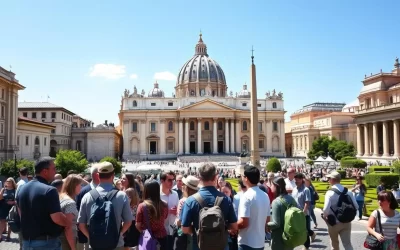✓ Accommodations✓ Flights✓ Rental Cars✓ Tours & Activities
Did you know that Vatican City is the smallest independent city-state in the world, spanning just 44 hectares? Despite its size, this iconic site holds immense historical and cultural significance. As you plan your visit, understanding its financial system is a crucial thing to ensure a smooth experience.
Vatican City uses the euro as its official currency, making transactions straightforward for many travelers. However, its unique status as a sovereign city means there are specific details you’ll want to know. From payment options to budgeting tips, this guide will help you navigate the financial aspects of your trip.
Whether you’re exploring St. Peter’s Basilica or marveling at the Sistine Chapel, being prepared with the right knowledge about currency and payments will enhance your visit. Let’s dive into the essentials to make your time in this remarkable site unforgettable.
Overview of Vatican City and Its Unique Economy
Nestled in the heart of Rome, the Vatican stands as the smallest sovereign nation on Earth. Spanning just 44 hectares, this city is a fascinating blend of history, culture, and spirituality. Its unique status as a country makes it a must-visit place for anyone exploring Italy.
Historical Background and Significance
The Vatican’s roots trace back centuries, with its rule deeply intertwined with the Catholic Church. At its heart lies St. Peter’s Square, a monumental area that has witnessed countless historical events. This iconic place is not just a symbol of faith but also a testament to the art and architecture that define the Vatican.
Every corner of this city tells a story, from the Sistine Chapel’s breathtaking frescoes to the treasures housed in its museums. It’s a home to some of the world’s most revered art pieces, captivating the mind of every visitor.
Modern Financial Infrastructure
Despite its ancient roots, the Vatican boasts a modern financial system. Its economy is supported by tourism, donations, and its own rule over its area. The Vatican Bank plays a crucial role in managing its funds, ensuring the city remains financially stable.
Here’s a quick look at some key financial aspects:
| Key Aspect | Details |
|---|---|
| GDP | $21 million (1999 estimate) |
| Population | 890 (2001 estimate) |
| Primary Revenue Sources | Tourism, donations, financial activities |
The Vatican’s unique blend of historical art and modern financial systems makes it a truly remarkable place. Whether you’re marveling at St. Peter’s Square or exploring its museums, this city offers an experience like no other.
Understanding the Currency in Vatican City
Understanding the currency system in Vatican City is key to a hassle-free visit. The official currency is the euro, which simplifies transactions for most travelers. However, the Vatican adds its own unique touch by minting its own coins, widely circulated within the eurozone.
Historically, the Vatican’s currency has evolved over the years. Before adopting the euro in 2002, it used the Italian lira. This change marked a significant shift, aligning the Vatican with modern European financial practices.
One of the most fascinating aspects is the Vatican’s unique coinage. These coins often feature iconic symbols, such as the Pope’s image or religious motifs. Collectors and visitors alike find them highly valuable and symbolic.
For those interested in history, the museum of currencies offers a deep dive into the evolution of money. It showcases ancient coins alongside modern ones, highlighting the blend of tradition and innovation in the Vatican’s financial system.
Understanding the currency is essential for every travel plan. It ensures you’re prepared for transactions, whether you’re buying souvenirs or paying for guided tours. With this knowledge, your visit to Vatican City will be both smooth and memorable.
Vatican: Ultimate Travelers Guide to Currencies & Payments
Exploring the financial and cultural aspects of your visit can make your experience unforgettable. This guide is designed to help you navigate the unique blend of history and modernity that defines this iconic destination.
Understanding local customs is essential, especially when visiting St. Peter’s Square. This historic site is not only a spiritual hub but also a place where financial transactions, like purchasing souvenirs or tickets, are part of the experience.
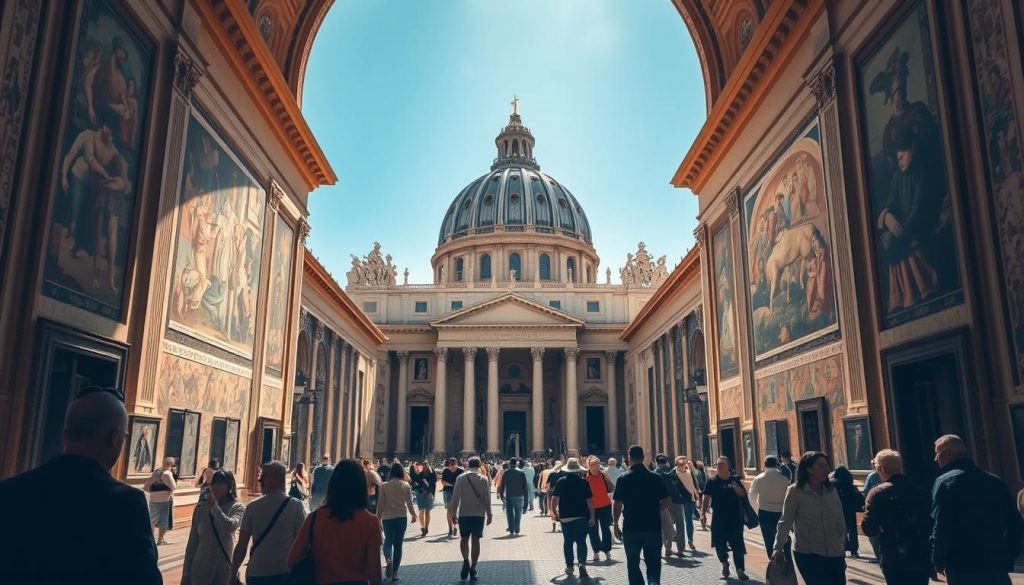
Your journey wouldn’t be complete without exploring the renowned museum collections. The Sistine Chapel, with its breathtaking frescoes, is a must-see. It’s a perfect example of how art and history intertwine with the practical aspects of travel, like ticket purchases and guided tours.
This guide merges historical insights with modern financial tips. Whether you’re admiring the Sistine Chapel or planning your budget, you’ll find everything you need here. Upcoming sections will dive deeper into payment options, booking strategies, and more.
- Learn about local customs at St. Peter’s Square.
- Discover the art and history of the museum collections.
- Plan your visit to the Sistine Chapel with ease.
By combining historical knowledge with practical advice, this guide ensures your trip is both enriching and hassle-free. Stay tuned for more tips on managing your finances and making the most of your visit.
Navigating Payment Options and Banking Services
Managing your finances during your visit is easier than you might think. The city offers a variety of options to ensure smooth transactions. Whether you prefer cash or cards, you’ll find convenient solutions to suit your needs.
Using ATMs and Currency Exchange
ATMs are widely available, especially near popular landmarks like St. Peter’s Square. They offer a quick way to withdraw euros, the local currency. Keep in mind that some machines may have a fee for international withdrawals.
Currency exchange services are also accessible, but it’s wise to compare fees before making a transaction. Avoid airport exchanges, as they often charge higher rates. Instead, opt for local banks or ATMs for better rates.
Credit and Debit Card Acceptance
Most establishments, including shops and restaurants, accept credit and debit cards. This reduces the need to carry large amounts of cash. Visa and Mastercard are widely recognized, making them a reliable option for travelers.
However, it’s always good to have some cash on hand for smaller purchases or places that don’t accept cards. Be prepared for occasional lines at ATMs, especially during peak hours.
| Service | Details |
|---|---|
| ATMs | Available near St. Peter’s Square, may charge a fee |
| Currency Exchange | Compare fees, avoid airport exchanges |
| Card Acceptance | Widespread, Visa and Mastercard preferred |
By understanding these options, you can navigate the financial landscape with ease. Whether you’re near St. Peter’s Square or exploring other areas, you’ll be well-prepared for a seamless experience.
Planning Your Budget for a Vatican Visit
Planning your budget for a trip to this iconic destination requires careful consideration of daily expenses. From food and transport to attraction fees, costs can add up quickly. By estimating your spending in advance, you can ensure a stress-free and enjoyable experience.
Estimating Daily Expenses
When visiting a high-traffic area, managing your money effectively is key. Start by listing all potential expenses, such as meals, tickets, and souvenirs. On average, a day in this historic site can cost between $50 to $150 per person, depending on your choices.
Transportation is another factor to consider. While walking is free, public transport or taxis will add to your budget. Attraction fees, like entry to museums or guided tours, can also impact your overall spending.
To maximize value, consider traveling during off-peak months like November or February. These periods often have lower prices and fewer crowds, making it easier to enjoy your visit without breaking the bank.
- Allocate funds for meals, transport, and tickets.
- Compare prices for guided tours and skip-the-line passes.
- Plan your visit during quieter months to save money.
For travelers seeking a cost-effective trip, advance planning is essential. By understanding your daily expenses and choosing the right time to visit, you can make the most of your journey without overspending.
Pre-Paid Tickets and Guided Tour Bookings
Securing your tickets early can transform your visit into a seamless and enjoyable experience. By planning ahead, you avoid long lines and ensure access to popular attractions, even during peak times.
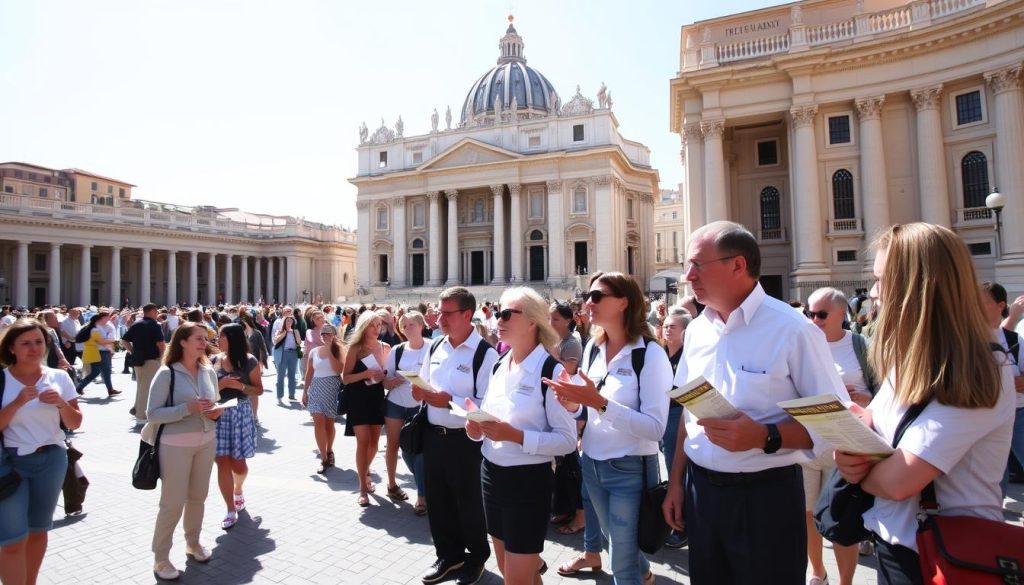
Benefits of Advance Reservations
Booking your tickets in advance offers several advantages. First, it saves you time by skipping the queues. Second, it provides peace of mind, knowing your spot is secured. Lastly, it often grants access to exclusive tours and discounts.
For example, many guided tours include skip-the-line access, allowing you to maximize your time exploring. “Pre-booking is a game-changer,” says one traveler. “It made our visit stress-free and more enjoyable.”
Here are some insider tips to make the most of your pre-booked tickets:
- Check for early bird discounts or bundled offers.
- Look for tours with smaller group sizes for a more personalized experience.
- Confirm cancellation policies in case your plans change.
Preparing early is an essential tip for every savvy traveler. By securing your tickets in advance, you ensure a smooth and memorable visit to this iconic destination.
Cost Considerations for Popular Attractions
Exploring the costs of visiting iconic landmarks can help you plan a budget-friendly trip. Popular attractions like the Vatican Museums and St. Peter’s Basilica come with varying fees, so understanding these costs is essential for a smooth experience.
Admission fees can differ widely depending on the place. For example, entry to the Vatican Museums costs €17 for adults, while children under 18 enjoy discounted rates. Some sites also offer bonus passes, which can save you money if you plan to visit multiple attractions.
Bundled ticket options are a great way to maximize value. These packages often include access to multiple sites at a reduced price. For instance, combining a visit to the Vatican Museums with a guided tour of St. Peter’s Basilica can be both cost-effective and time-saving.
The unique status of this country also influences pricing. As a historic area, it attracts millions of visitors annually, which can drive up costs during peak seasons. Planning your visit during quieter months can help you avoid inflated prices.
When purchasing tickets, always use reputable sites to avoid scams. Official platforms ensure you get the best deals without hidden fees. “Booking through trusted sources gave me peace of mind,” says one traveler.
- Compare admission fees and bonus passes for each attraction.
- Look for bundled ticket options to save money.
- Use official sites to avoid scams and ensure authenticity.
By understanding these cost factors, you can make informed decisions and enjoy your visit without overspending. Whether you’re marveling at the Vatican Museums or exploring other historic sites, careful planning ensures a memorable experience.
Travel Tips for Managing Expenses in Vatican City
Making the most of your visit involves smart planning and awareness of common pitfalls. Whether you’re exploring the Sistine Chapel or strolling through historic sites, these tips will help you save money and avoid scams.
Avoiding Tourist Scams
Popular destinations often attract scammers looking to take advantage of unsuspecting visitors. Be cautious of individuals offering unofficial tours or selling fake tickets. Always purchase from authorized vendors to ensure authenticity.
Another common tactic is overcharging for goods or services. For example, vendors near major attractions may inflate prices for snacks or souvenirs. A simple tip is to carry your own water and snacks to avoid these inflated costs.
Lastly, be wary of distractions like fake petitions or street performers who may use sleight of hand to steal your belongings. Staying alert and keeping your valuables secure is the best way to protect yourself.
Smart Money-Saving Strategies
Planning ahead can significantly reduce your expenses. One effective way is to visit during off-peak times, such as November to March. This not only saves money but also lets you enjoy the attractions with fewer crowds.
Pre-booking tickets is another great tip. Many sites, like the Sistine Chapel, offer skip-the-line options, saving you time and stress. Additionally, look for bundled deals that include multiple attractions at a discounted rate.
Transportation costs can also add up. Walking is the best way to explore the area, but if you need to travel further, public transport is a budget-friendly option. Avoid taxis unless absolutely necessary.
- Visit during off-peak months for lower prices and fewer crowds.
- Pre-book tickets to skip long lines and secure discounts.
- Use public transport or walk to save on travel costs.
By following these strategies, you can enjoy your trip without overspending. Whether you’re admiring the Sistine Chapel or exploring other iconic sites, these tips will enhance your experience.
Guide to Using the Euro in Vatican City
When visiting this historic site, understanding the euro’s role is essential for a smooth experience. As the official currency, it simplifies transactions, making it easier to explore iconic landmarks like St. Peter’s Basilica.
The euro is widely accepted, eliminating the need for currency exchange if you’re traveling from other Eurozone countries. This convenience allows you to focus on enjoying the art and history without worrying about financial logistics.
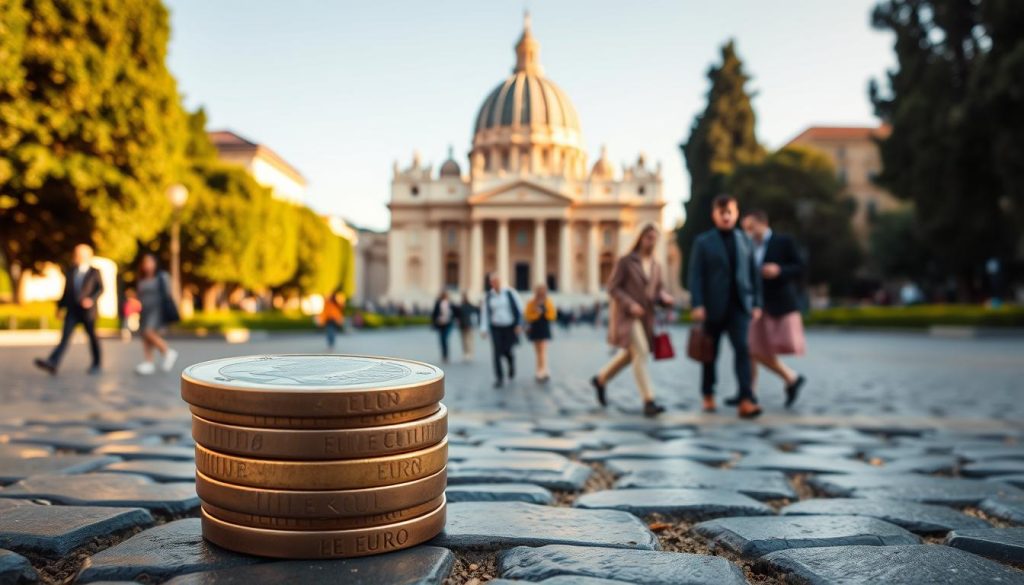
One unique aspect is the local coinage. Vatican coins often feature designs inspired by St. Peter’s Basilica and other religious symbols. These coins are not only functional but also serve as memorable souvenirs for collectors.
When exchanging currency, be mindful of fees. ATMs and banks near popular sites typically offer competitive rates. Avoid exchanging money at airports or tourist hotspots, as they often charge higher fees.
Here’s a quick guide to using the euro effectively:
- Carry small denominations for easier transactions at local shops.
- Use credit or debit cards for larger purchases to avoid carrying excess cash.
- Check for any fees associated with international transactions on your cards.
By understanding the currency system, you can make the most of your visit. Whether you’re admiring the art or exploring the history, the euro ensures a hassle-free experience.
Visa and Entry Requirements for U.S. Travelers
Planning a trip to this historic site involves understanding the visa and entry requirements for U.S. travelers. As part of the Schengen Area, this destination follows specific rules that ensure a smooth entry process.
Schengen Visa Essentials
If you’re a U.S. citizen, you can visit for up to 90 days within a 180-day period without a visa. However, your passport must be valid for at least three months beyond your planned departure date. This rule applies to all Schengen countries, including this iconic location.
For longer stays, you’ll need to apply for a Schengen Visa. The process involves submitting documents like proof of accommodation, travel insurance, and financial means. “Applying early is key,” says one traveler. “It ensures you have everything ready before your trip.”
When entering, be prepared for security checks at the entrance. Lines can be long, especially during peak tourist seasons. Arriving early or booking skip-the-line tickets can save you time and stress.
Here are some tips to navigate the process:
- Check your passport’s expiration date before traveling.
- Carry copies of your travel documents, including your visa if required.
- Be aware of currency exchange options, as the euro is the official currency.
Exploring landmarks like St. Peter’s Basilica is a highlight of any visit. Knowing the entry requirements ensures you can focus on enjoying the experience without any last-minute surprises.
Embracing Mobile and Contactless Payment Solutions
As technology evolves, so do the ways we handle transactions during travel. Mobile and contactless payment systems are becoming increasingly popular, offering convenience and efficiency for visitors. These solutions are especially useful in high-traffic areas, ensuring smooth transactions even during peak hours.
Digital Wallets and Payment Apps
Digital wallets and payment apps are transforming how we pay for goods and services. They allow you to store multiple payment methods securely on your smartphone. This eliminates the need to carry cash or multiple cards, making transactions fast and hassle-free.
One of the benefits of using digital wallets is their widespread acceptance. Many shops, restaurants, and even entrance points for attractions now support these systems. Apps like Apple Pay, Google Pay, and Samsung Pay are widely recognized, ensuring compatibility wherever you go.
Here’s how you can make the most of these payment solutions:
- Link your credit or debit card to a trusted digital wallet app.
- Use contactless payments for quick transactions, especially during busy hours.
- Check for updates or new features each month to stay ahead of trends.
Managing your payment methods effectively is key to a seamless experience. Keep your apps updated and ensure your device is charged, especially when visiting popular entrance points. This preparation ensures you’re ready for any transaction, no matter the time of day.
By embracing these modern solutions, you can enjoy a more efficient and stress-free visit. Stay informed about the latest payment technologies to make the most of your trip.
Impact of the Jubilee Year on Visitor Costs
The Jubilee Year brings a unique blend of spiritual significance and increased visitor activity to this historic site. Every 25 years, this event attracts millions of pilgrims and tourists, significantly impacting costs and demand. Understanding these changes can help you plan a more efficient and budget-friendly visit.
During the Jubilee Year, visitor numbers surge, often doubling or tripling compared to regular years. This increased demand affects everything from ticket prices to local vendor fees. For example, general admission to popular attractions like the museums and chapels may rise, and accommodations often book up months in advance.
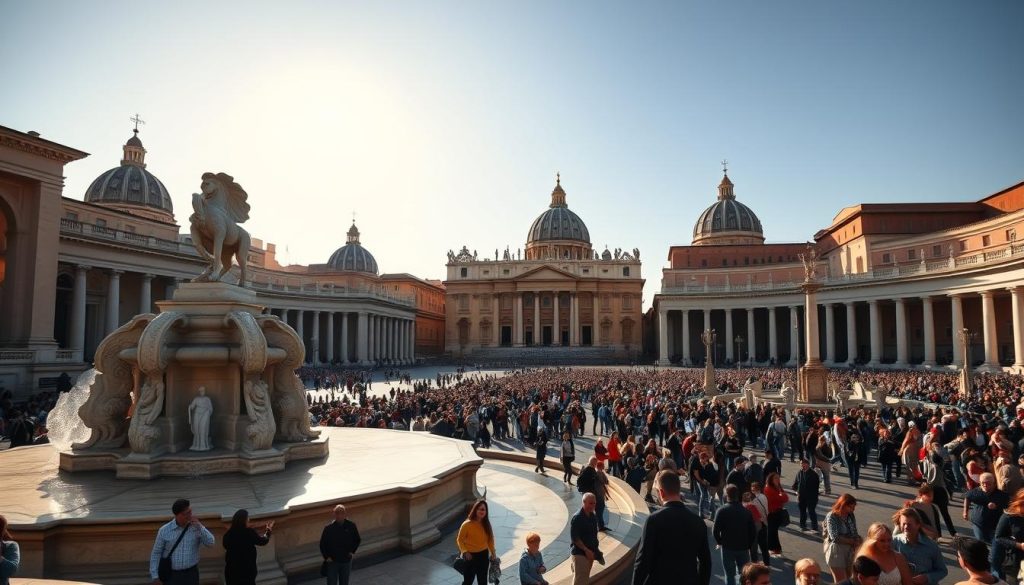
Historical trends show that the Jubilee Year creates a ripple effect on expenses. Hotels, restaurants, and transportation services often adjust their pricing to match the higher demand. “Planning ahead is crucial,” says one traveler. “Prices can skyrocket if you wait too long.”
Here’s a quick overview of how costs typically change during this significant year:
| Category | Regular Year | Jubilee Year |
|---|---|---|
| Accommodation | €100-€150/night | €200-€300/night |
| Museum Tickets | €17 | €20-€25 |
| Transportation | €1.50 per ride | €2.00 per ride |
To manage expenses effectively, consider these strategies:
- Book accommodations and tickets at least six months in advance.
- Travel during off-peak months like November or February to avoid higher prices.
- Use public transport or walk to save on travel costs.
By understanding the impact of the Jubilee Year, you can plan a more enjoyable and cost-effective visit. Whether you’re exploring iconic landmarks or attending spiritual events, preparation is key to making the most of this unique experience.
Practical Advice for Payment Security and Money Management
Ensuring your financial safety while traveling is just as important as planning your itinerary. Crowded environments can pose risks, but with the right strategies, you can protect your funds and personal information effectively.
Start by understanding payment security. Always use trusted apps for transactions. Apps like Apple Pay and Google Pay offer encrypted payments, reducing the risk of fraud. Avoid sharing sensitive details over public Wi-Fi, as it can be easily compromised.
When withdrawing money from ATMs, choose machines located in secure areas, such as banks or well-lit public spaces. Shield your PIN while entering it, and be cautious of anyone standing too close. “Using ATMs inside banks is always safer,” advises a frequent traveler.
For large purchases, consider using credit cards with fraud protection. Many banks offer zero-liability policies, ensuring you’re not held responsible for unauthorized charges. Check for foreign transaction fees, as they can add up quickly.
Here’s a quick guide to managing your finances securely:
| Tip | Details |
|---|---|
| Use Secure Apps | Opt for encrypted payment apps like Apple Pay or Google Pay. |
| ATM Safety | Choose ATMs in secure locations and shield your PIN. |
| Fraud Protection | Use credit cards with zero-liability policies for large purchases. |
Finally, diversify your payment methods. Carry a mix of cash, cards, and digital wallets. This ensures you’re prepared for any situation while minimizing risks. By following these tips, you can focus on enjoying your trip without worrying about financial security.
Additional Resources for Vatican Travel and Finance
To make your trip planning smoother, here’s a curated list of resources that every visitor should explore. These tools and guides provide detailed insights into managing your finances and enhancing your travel experience.
Recommended Web Sources and Further Reading
For comprehensive travel advice, check out these trusted posts and websites. They offer up-to-date content on everything from budgeting to cultural tips.
- Lonely Planet: A go-to resource for travel guides, including detailed sections on Vatican City.
- TripAdvisor: Read reviews and tips from fellow travelers to plan your itinerary effectively.
- Rome2Rio: A handy tool for planning transportation routes and estimating costs.
Financial blogs like NerdWallet and The Points Guy are excellent for understanding currency exchange and payment options. They provide practical advice tailored for travelers.
- “Budgeting for Vatican City: A Comprehensive Guide”: A detailed breakdown of daily expenses and money-saving tips.
- “Navigating Currency Exchange in Europe”: Learn how to get the best rates and avoid hidden fees.
- “Top Vatican Museums You Can’t Miss”: A curated list of must-see attractions and ticket booking advice.
These resources are designed to enhance your trip planning and financial management. Bookmark them for easy access during your travels.
| Resource | Key Features |
|---|---|
| Lonely Planet | Detailed travel guides, cultural insights, and budgeting tips. |
| TripAdvisor | User reviews, itinerary suggestions, and cost estimates. |
| Rome2Rio | Transportation planning and cost comparisons. |
By leveraging these tools, you can ensure a well-organized and enjoyable visit. Whether you’re managing your budget or exploring iconic sites, these resources are invaluable for every traveler.
Conclusion
Exploring the financial landscape of this historic destination can transform your trip into a seamless experience. Understanding the currency and payment options ensures you’re prepared for every transaction, from buying souvenirs to dining at local restaurants. Every person visiting should remember to carry small denominations of cash and use secure payment apps for convenience.
By applying these insights, your visit becomes more enjoyable and stress-free. Planning ahead, whether it’s booking tickets or budgeting for daily expenses, makes your life easier. These tips not only save time but also enhance your overall experience in this iconic world destination.
Take these practical steps to heart and make the most of your journey. With the right preparation, you can focus on creating unforgettable memories without worrying about financial details.
The above is subject to change.
Check back often to TRAVEL.COM for the latest travel tips and deals.
